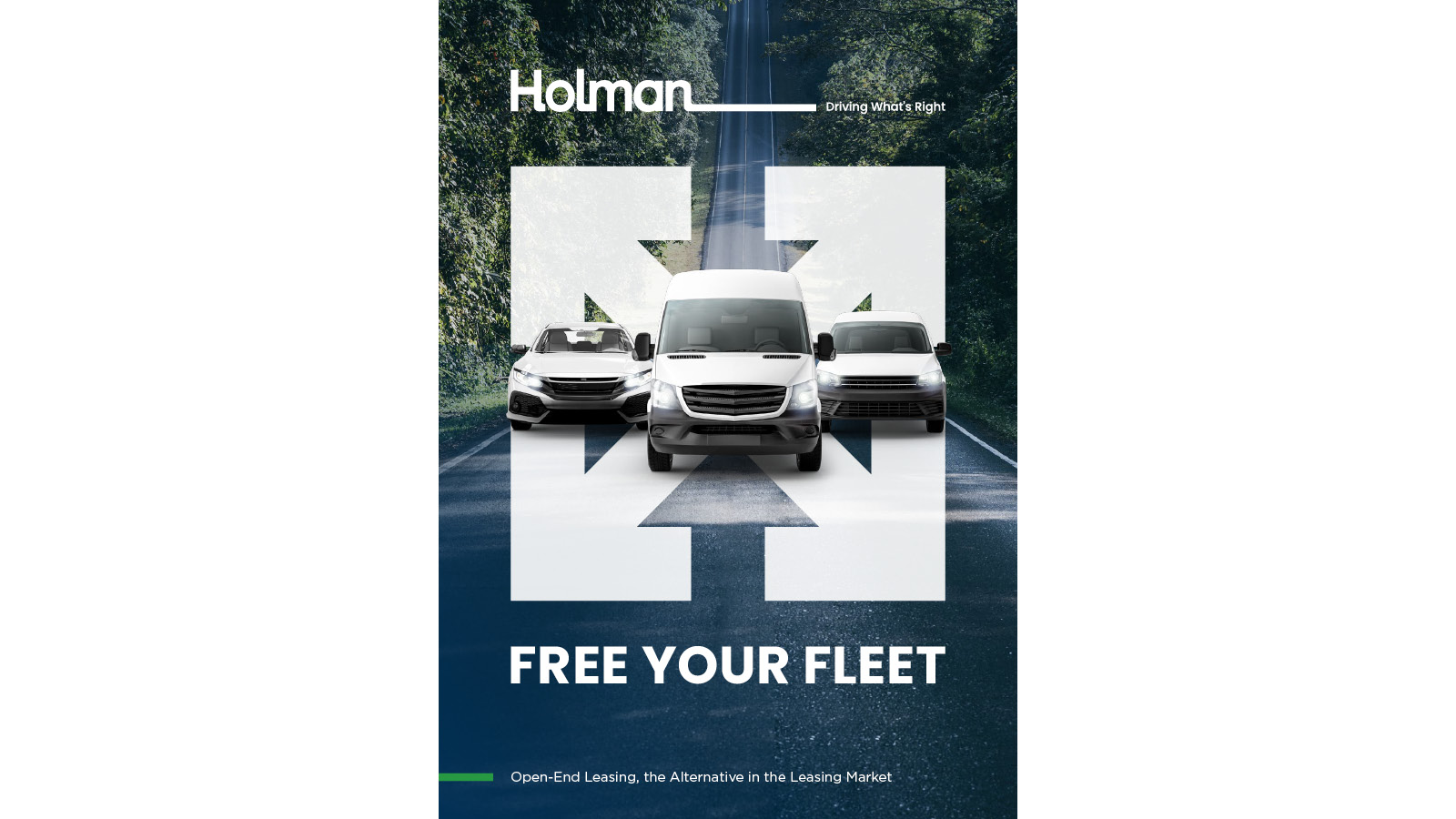-
What We DoWith our integrated fleet services, you get the entire fleet management and leasing market from a single source and can purchase, finance, manage and sell your fleet cost-effectively. And you only ever pay for what you actually use.Overview
-
ResourcesWe have a lot to share. Browse our resources library for current insights, data, strategies, and success stories from our own experts in their respective fields.Overview
-
About UsWhen Holman was founded in 1924, we set something positive in motion. Our consistent focus on people and our commitment to integrity make us who we are today.Overview
 Join Our TeamWe’re not just in the automotive business, we’re in the people business. Join us for the ride.Browse Careers
Join Our TeamWe’re not just in the automotive business, we’re in the people business. Join us for the ride.Browse Careers
HIRE PURCHASE
The Financing Alternative for your Fleet
We advise you on the way to the right form of financing for your fleet. Hire purchase is also one of the most common forms of finance leasing. This alternative can be worthwhile for your fleet.

What is Hire Purchase?
If you opt for hire purchase, colloquially also known as residual value leasing, the leasing installments paid will only cover part of the lessor’s total costs during the contract period. To determine the leasing rate, a realistic residual value is set and reported transparently. Therefore, this model is often referred to as “residual value leasing”. We offer this type of leasing in the following contract forms:
- Hire purchase with put option
- Hire purchase with additional revenue sharing
- Hire purchase offers many advantages and is a good alternative to classic leasing contracts.
The advantages:
- possible tax benefits
- no reduction in value at the end of the leasing term as with classic mileage leasing
You can find an overview of the most common forms of financing here.


What alternatives are there?
Hire purchase contract with right to tender: At the end of the contract, the lessor has the right to tender (“sell”) the vehicle to the lessee at the price already fixed when the leasing contract was concluded. Contrary to what is often thought, a legal transfer of ownership to the lessee is not certain when the contract is concluded and the lessee also has no right to buy. If the imputed residual value is lower than the market value at the end of the contract, the lessor has the right to sell the vehicle. If the market value is lower than the imputed residual value, the lessor can offer the vehicle to the lessee at the residual value.
An advantage of this leasing variant is that you do not receive a reduction in value at the end of the leasing period, as is the case with classic mileage leasing. Nevertheless, you should of course still take good care of your car or you risk that the market value is below the calculated residual value.

What is hire purchase with profit participation?
Hire purchase with additional revenue participation: The lessee participates in the additional revenue from the sale of the vehicle. Additional revenue is achieved if the sales revenue exceeds the final payment stipulated in the contract. In this case, the lessee is entitled to 75% of the additional proceeds. If the proceeds from the sale are below the stated residual value, the lessee would have to pay the difference. The contract has a fixed term and here, too, the leasing rates already paid do not lead to full amortization. Important to know: Taking good care of the vehicle is particularly worthwhile with this type of financing. Because if the property is well cared for, the price on the market will be reflected accordingly and the lessee will share in the proceeds.
At Holman, we offer you both financing options.

We will help you to find a suitable solution - feel free to contact us!
GET IN TOUCH
×
E-BOOK
Free up your fleet with open-end leasing
Contract parameters such as term & mileage motivate rigid fleet management. Flexible management is much more efficient and should not be obstructed. Our white paper shows you how to free your fleet from rigid contract parameters and opaque costs.


Hire Purchase Frequently Asked Questions
-
What is hire purchase with the right to tender?
An advantage of this leasing variant is that you do not receive a reduction in value at the end of the leasing period, as is the case with classic mileage leasing. Nonetheless, you should take good care of your car or you risk having the market value fall short of the calculated residual value.
An advantage of this leasing variant is that you do not receive a reduction in value at the end of the leasing period, as is the case with classic mileage leasing. Nonetheless, you should take good care of your car or you risk having the market value fall short of the calculated residual value.
-
Why is hire purchase with profit participation?
We would be happy to discuss which form is right for you and your fleet. At Holman, we offer you both financing options. In addition, we offer open-end leasing as a core product with FlexLease.
-
What is open-end leasing?
In 2017, Holman redefined open-end leasing in Germany with its FlexLease product, a flexible full payback financing contract.
To put it simply, the differences to mileage leasing lie in the flexibility and regulation of the sales proceeds. Flexibility means that you can easily extend or shorten the duration of the contracts. Or that the number of kilometers driven does not have to be determined in advance. This is often very useful, since the exact use of a fleet is difficult to predict. In open-end leasing, this is quite easy.
- A flexible contract is entered into when the contract is concluded. Instead of often non-transparent “calculations”, a repayment plan is agreed that is as transparent as possible. Since not every car is used in the same way, there is an optimized, individual financing contract for every vehicle.
- During the term, open-end leasing offers reliable, constant monthly payments, with all services clearly defined. The term is flexible from as little as three months: After this period, the contract can be terminated at any time by paying the remaining debt – the vehicle is yours.
- After the end of the term, we do not issue a reduction in value statement, as it does not reflect the loss in value. You can continue to drive the vehicle, sell it yourself or let us sell it. Either way, the proceeds are yours.
-
What is mileage leasing?
Only rarely can a car be used exactly as planned. Then, with closed-end leasing, costs can arise that are not always apparent in the contract clauses at first glance: every kilometer that is driven costs more. But every kilometer that is driven less does not cost correspondingly less. The kilometer is remunerated at a lower rate and is also capped. Reduced value payments for damages are added to this. All of this can add up until the original calculation no longer fits. Anyone who has been in the business for a while knows that billing is done at the end and with leasing there is often the big end in the form of additional payments. It doesn’t feel right in a way, but then in the next procurement round you do it again until you get used to it.
-
How can I save costs with FlexLease (open-end leasing)?
With FlexLease you only pay for the financing for all vehicle types,
ie:
- no costs for contract adjustments
- no prepayment penalty in the event of premature contract termination
- No extra/short mileage billing due to mileage limitation
- no costs due to damage and reduced values at the end of the contract
- the residual value margin is yours
-
What are the advantages of FlexLease (open-end leasing)?
Our expert tip: FREE YOUR FLEET, free your fleets from contractual constraints. We would be happy to help you calculate the benefits of FlexLease for your fleet. Even if FlexLease is not the optimal solution, we will find the right financing option for you. You can rely on it.
Related Services

Vehicle Management
Our fleet management services help you use and maintain all aspects of your fleet to save time, control costs and avoid downtime.

Technology and Data Intelligence
Holman uses Big Data to deliver actionable insights to help you reduce costs, streamline processes, and gain a clear view of your fleet’s operations.

Electromobility
Together with you, we develop a long-term sustainability plan for your fleet and support you in the implementation to strategically convert your fleet from combustion engines to e-vehicles in this way.
It looks like you've navigated to our Holman DE-EN website and are located outside of this region. Would you like to continue or select a different region?
✕

